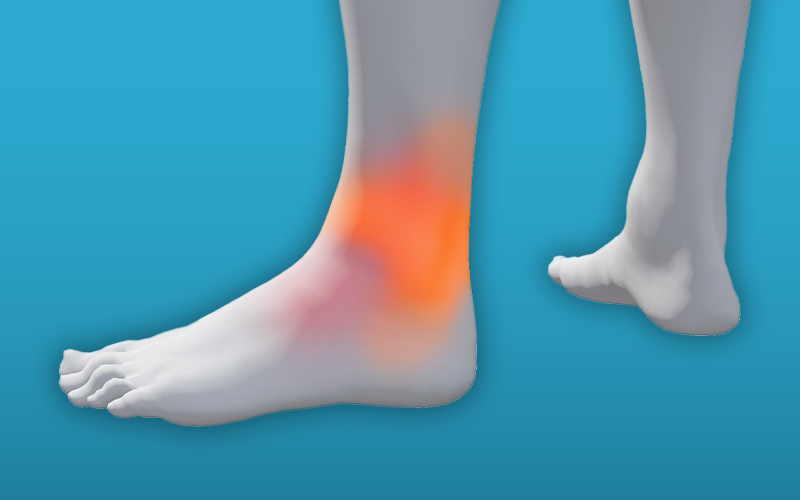
Early management of sprains and strains
An ankle sprain or strain is a soft tissue injury. Most ankle sprains and strains can be managed at home. Typically there will be an event which causes pain i.e. slip, trip or fall.
A soft tissue injury to the ankle may result in the following:
- Pain
- Swelling
- Bruising
- Stiffness and loss of function
The pain can be particularly strong in the first three weeks as this is the inflammatory phase of your body healing itself. Typically, these injuries last 4 to 6 weeks depending on the severity.
Painkillers like paracetamol will ease the pain, but need to be taken regularly in order to control the pain. Always follow the instructions on the packet.
Anti-inflammatories like ibuprofen can help with swelling, and therefore help you move more freely. Follow the instructions on the packet and discuss using them safely with a pharmacist, especially if you have any underlying health conditions
However, you should not take ibuprofen for 48 hours after an initial injury as it may slow down healing.
Up to date guidelines can be found on the NHS website:
Most ankle sprains or strains can be managed at home.
Go to an urgent treatment centre or emergency department if you:
- have severe pain
- feel faint, dizzy or sick from the pain
- have an ankle or foot that has changed shape or is at an odd angle
- heard a snap, grinding or popping noise at the time of injury
- are not able to walk
These could be signs of something more serious.
You can also call 111 for advice or go 111.nhs.uk.
Speak to a GP or physiotherapist if:
- the pain is severe or stopping you doing normal activities
- the pain is getting worse and/or keeps coming back
- the pain has not improved in any capacity after following the simple advice below
- Click here to self-refer to a physiotherapist.
How to manage a sprain or a strain
DAY 1 – Early Management
Protect by minimising use of the affected area and initially avoiding stretching the area which could cause further injury. You may need a walking aid to help you get around.
Rest can be beneficial in the very early stages of the injury (days 1-4). In the early stages, gentle active movements and specific exercises can help decrease pain and swelling, they also promote good tissue healing with less unwanted scar tissue and joint stiffness.
Ice pack/frozen peas wrapped in a damp cloth, placed on the swollen ankle for up to 20 minutes at a time, 3 times a day. So long as there is swelling you will need to continue ice therapy, often beyond the third week.
- Please note only use ice if you have normal skin sensation
- Check the skin regularly
- Stop if there is excessive pain, numbness or tingling
- Do not put ice directly on to the skin as this may cause a burn.
Compression of the swollen ankle can be achieved by using a tubigrip or crepe bandage, this should reach from just below the knee to the ball of your foot/toes. It should compress firmly but not restrict flow and create a tourniquet.
Elevation. Gravity causes fluids to gather in the ankle. By elevating your foot you can manage this problem. Elevate your leg by putting a pillow/blanket under your feet.
WEEK 1 – Early Mobilisation
These exercises should be performed three times daily.
Foot and ankle exercises
1. Sitting or lying. Rotate your ankle so you are drawing circles with your foot. Change directions.
Repeat 10 times.

2. Sit with one leg straight out in front of you. Put a towel around your foot.
Gently pull the towel and feel the stretch in your calf.
Hold approx. 30 secs. Repeat 3 times.

3. Heel and toe tapping 3 minutes 3 times / day 20 second hold three times 3 minutes 3 times / day.

WEEK 2 – Strengthening Exercises
Stand tall, with your weight distributed evenly on both feet, and take support if needed.
Rise up onto your toes and in a controlled manner return to the starting position.
Repeat 10 times x 3

Balance practice
Holding on to something to start with, transfer weight from one foot to another. Then try doing this without support.
Progress the exercise to balancing on one foot.
To increase difficulty close eyes or place arms above head/ throw a ball against a wall.
Start to progress from walking, to fast walking as able. Try to walk as normally as possible.
As you start to do these exercises you may feel there is some discomfort, however, this is okay and you should continue. If you have discomfort and pain for more than 2 hours after these exercises, then you shoulder reduce the number and gradually build up again.

Balance board exercise
It is important to regain confidence and strength in your ankle. When the above exercises are easy to do you may find wobble board exercises beneficial for your recovery. You should speak with a healthcare professional before trying these exercises.

Recovery time and returning to activity
It usually takes 6 weeks to heal from simple soft tissue injuries to the ankle. However, everyone recovers from injuries at different rates. Some may be back in 2 weeks however for some it can take up to 3 months.
Returning to work – Gradually build up your strength and function, practice doing similar tasks that you would do at work before returning. Start doing this little and often ensuring there is minimal pain or swelling.
Returning to hobbies/sport – it is advised not to return to these activities until you have full strength and range of movement without pain or swelling. Try to practice the specific movements of your hobby / sport in a controlled manner and build up the time and intensity that you do the movements before returning to your activity fully.
